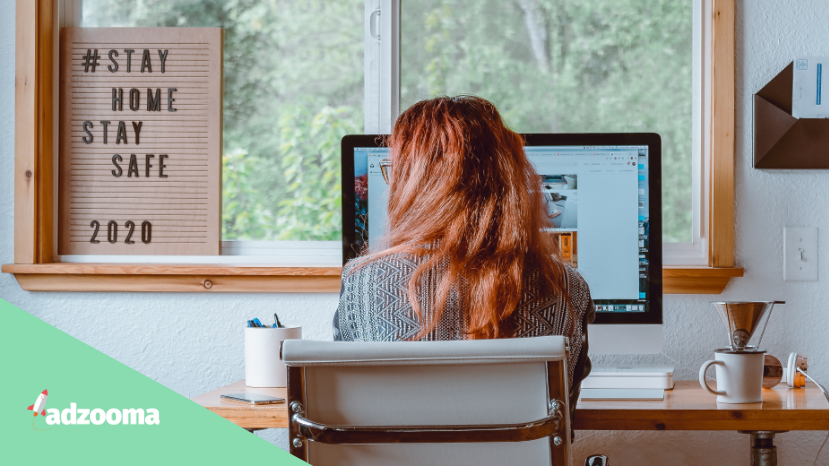The global pandemic has changed lives all over the world. While the crisis is in its peak, businesses have closed their physical doors and sent workers home. In the UK, more than 60% of the adult population is working from home during the Coronavirus lockdown.
We’ve been no different at Adzooma. Our offices shut their doors back in March and we haven’t been back since.
But now everyone has had a taste of working from home, will we ever return back to a traditional office?
To find out, we surveyed 447 workers* and interviewed dozens of businesses about their current plans and opinions. In addition, we also asked key experts Professor Irene Hardill, Dr Daniel Wheatley and psychotherapist Paul Ansorge for their thoughts on what’s in store and how this will affect workers both physically and mentally.
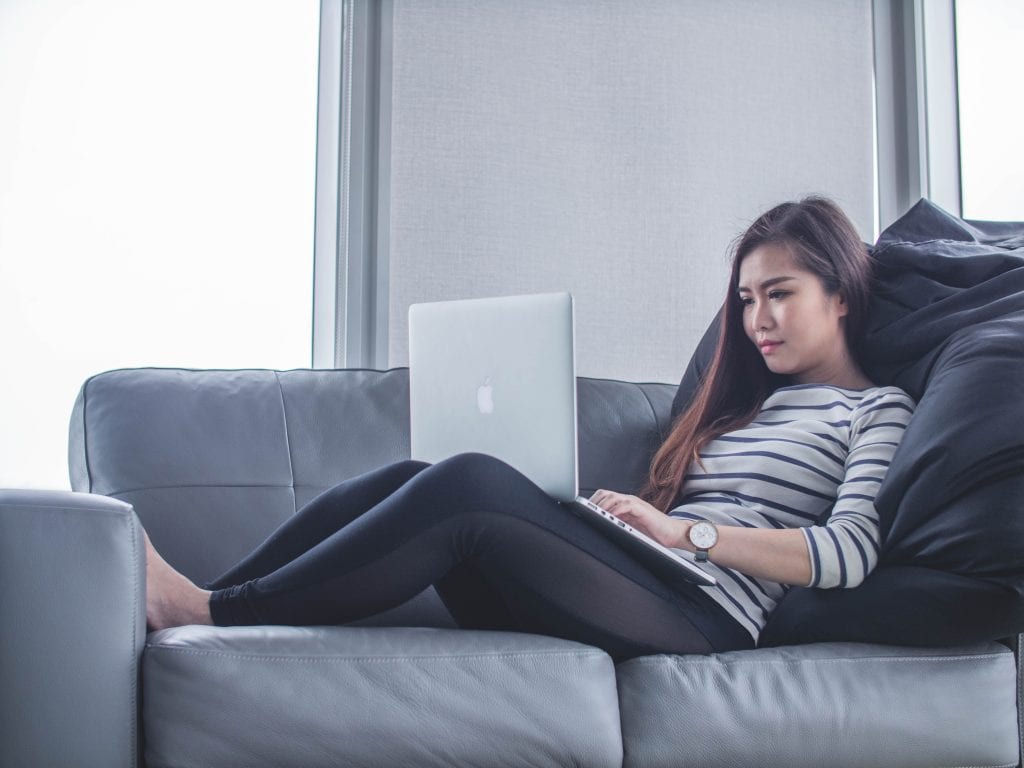
An end to the traditional office?
“We are seeing the world change before our eyes. Yes, COVID-19 will change the traditional office forever. [This is] the next step in an evolutionary process.”
Eric Chen – Associate Professor, University of Saint Joseph
The traditional office as we know it today may no longer exist. Even after the pandemic has passed the worst, social distancing and hygiene rules will change the way an office will look and work.
Initially, returning to an office environment might see employees doing 1-2 days in an office on a rotating basis to ensure safe social distancing, as Daniel Clark of Northern Flags tells us.
Physically, offices may have to implement features such as staggered workstations, sneeze guards and one-way corridors. It may also include new density plans to create physical distance within offices, policies to limit the number of occupants in shared spaces, remote check-in on smart devices to monitor density, touch-free doors and cleaning stations at key locations.
HF Planners LLC owner Caroline Shelly also echoes this, starting other changes such as hand sanitiser stations and “a change to automated controls for lighting, faucets and door openings”, physically changing the way we move and interact around the office.
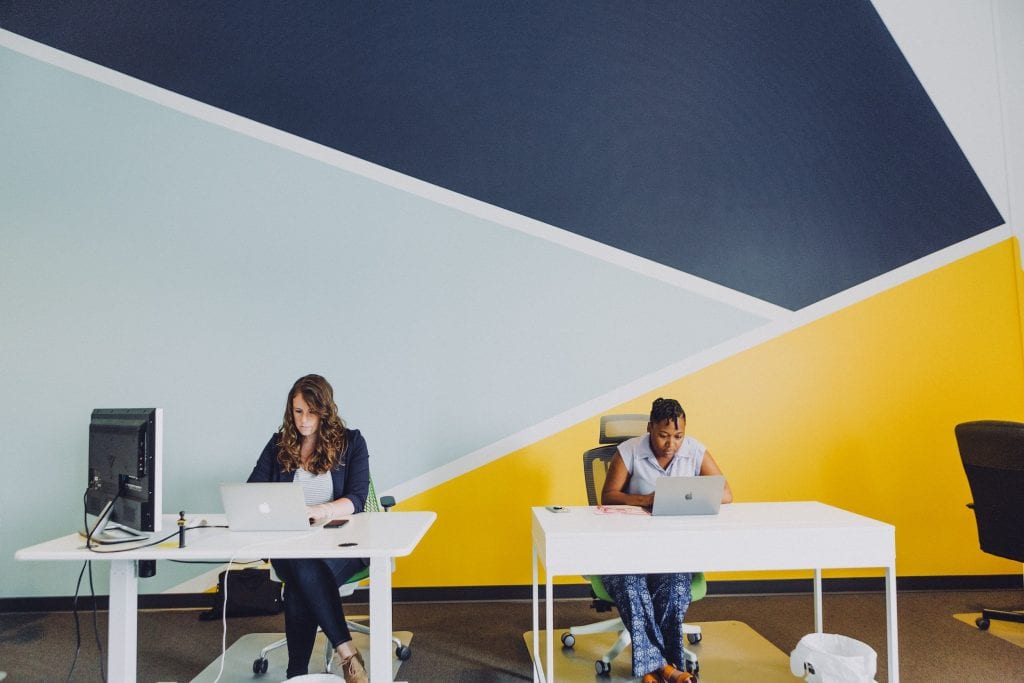
Is this the start of a remote working future?
“The world is getting a glimpse of what remote work can do for you, and I don’t think anyone will want to go back. Soon, everyone will be clamouring to work from home. The coronavirus will be the catalyst that will trigger the change. Office spaces will be a thing of the past.”
Jeremy Harrison – Founder of Hustle Life Media, Inc.
“With digital tools of outreach getting better and better, there is less and less incentive to invest in traditional offices. The only thing that kept them going the way that they have is the fact that people were far too used to doing things the old and familiar way.
The forced lockdown on account of COVID-19 has changed all that in one fell swoop. People now have first-hand experience at working in an environment different from working in a traditional office and once they figure out how advantageous that is, they may be loath to return to old ways. At best, they might spend part of their time working in a traditional office and part away from it.”
David Walter – Electrician Mentor
Before COVID-19, a Workplace Intelligence report showed that 69% of employees felt working remotely would improve their work and their personal lives. Now the pandemic has made this a reality, do people view remote working in the same light?
On the whole, this pandemic has proven one thing. Those who can work at home, can work at home well. So what role does the traditional office now offer if the same level of output and productivity can be achieved at home?
We surveyed over 400 people to find out their experiences and whether they want to go back to a normal office or not. These are the results.
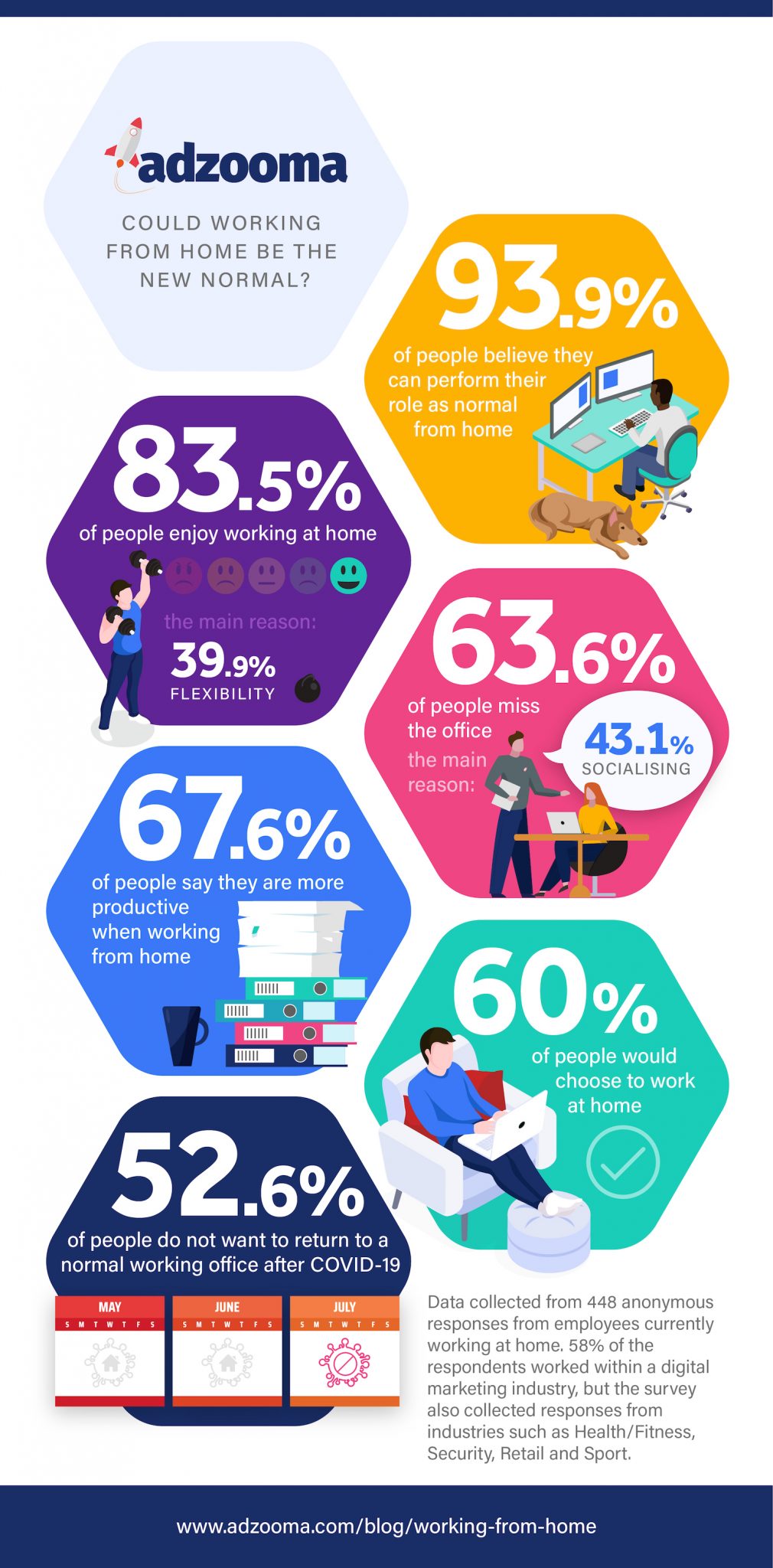
93.3% of people can work as normal from home
“I think that the reason most businesses choose to not have their employees work from home is due to a lack of monitoring and a lack of collaboration. With modern technology, these worries are no longer an issue, and working from home is financially less expensive for a company.”
Tom Mumford – Co-Founder of Undergrads LLC.
There’s a common misconception with traditional offices that you need to be there to get your job done. But with the technology available today, including the ability to have video conference calls in place of meetings and send quick messages to coworkers via communication apps like Slack or Skype, this just isn’t the case anymore.
Our data shows that 93.3% are able to perform their job as normal, from the comfort of their own homes.
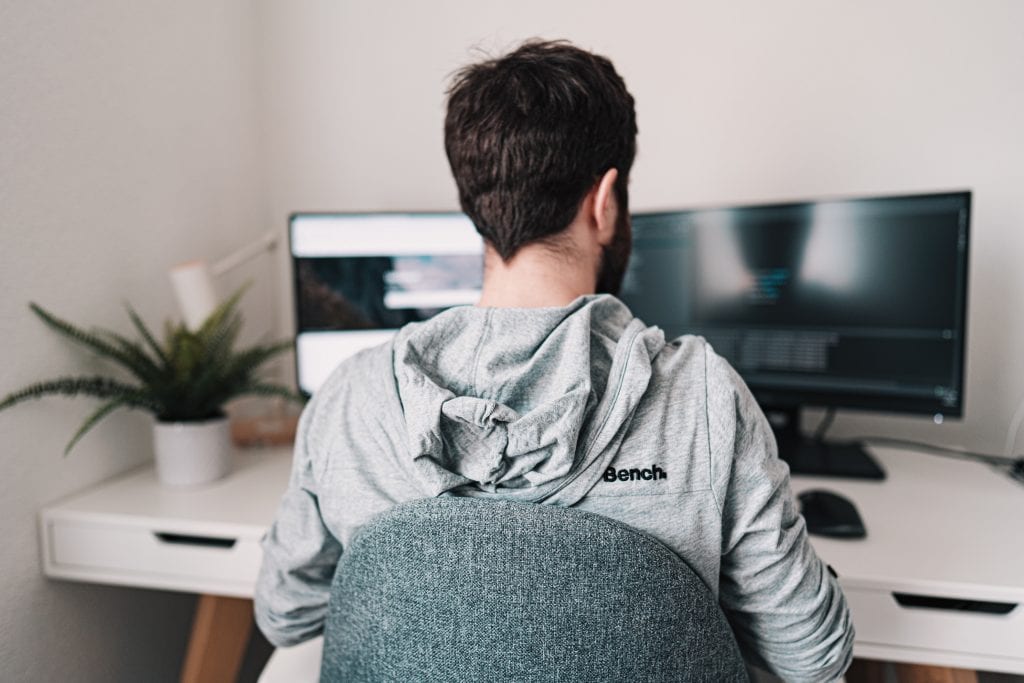
83.5% of people enjoy working at home
“I don’t see a need for the traditional office environment for the majority of companies, and personally believe it can often create situations where people are less productive on the whole. Working from home allows people to focus and get their work done, without “waiting for the clock to run out” on their work day.”
Chandell Gadbois – Syfter
For the majority of people, working at home is an enjoyable experience. In our survey, 83.5% people said that they enjoy working at home, even during a global pandemic.
This is what people said they liked most:
- 39.9% said the flexibility
- 37.6% said the lack of commuting
- 13.4% said the space to concentrate
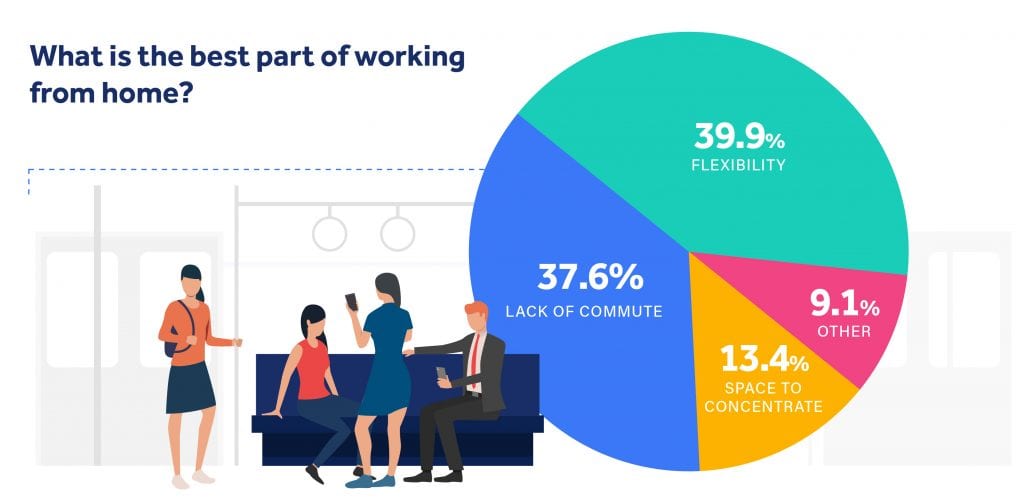
Other responses included not having to keep up a ‘work persona’, wearing comfortable clothes, fewer interruptions and having “a workspace that is perfectly set up for my needs”.
“No commute means no stress. You also tend to save on fuel, you can work comfortably and take a nap wherever you want. Spend time with your family and enjoy your own time.”
Avinash Chandra – founder and CEO of BrandLoom
67.6% more productive when working at home
67.6% of respondents said they are more productive when working at home. This answer wasn’t too surprising, as it’s a lot easier to get more done without the distraction of others around.
Traditional offices are great for many reasons, but one of the biggest flaws is the distractions. People can physically interrupt you, there always seems to be something going on and it’s easy to lose the odd 10 minutes even just having a natter with a coworker while making a brew. Although the social side is good, if you’ve got tight deadlines to hit, the distractions are a nightmare.
At home, you can set your notifications to Do Not Disturb and get it all done. That’s productive.
43.1% of people missing socialising in the office
“We are social animals, and being together in a physical space makes a big difference to how we interact.”
Rob Watling – Director of Peak Fireworks Ltd.
63.6% of respondents said they miss working in an office. When asked what they miss most, 43.1% of people said socialising.
For some industries, having physical meetings aren’t just a preference but an essential. Therapist Katie Leikam told us that seeing clients in person helps her to read the body language of her clients, as well as establish a connection with them. Despite that, Katie is planning on staying at home for 1-2 days a week to video call clients that live further away and better manage her schedule around her home life.
David Pipp of Living Low Key also echoed this, stating that a major downside of working from home is not being able to read facial expressions during phone meetings. “It can be hard to tell how someone is reacting to a discussion without that”.
Other answers to what people missed in the office are:
- Face-to-face meetings with 15.7%
- Communication with 14.8%
- Structure with 10%
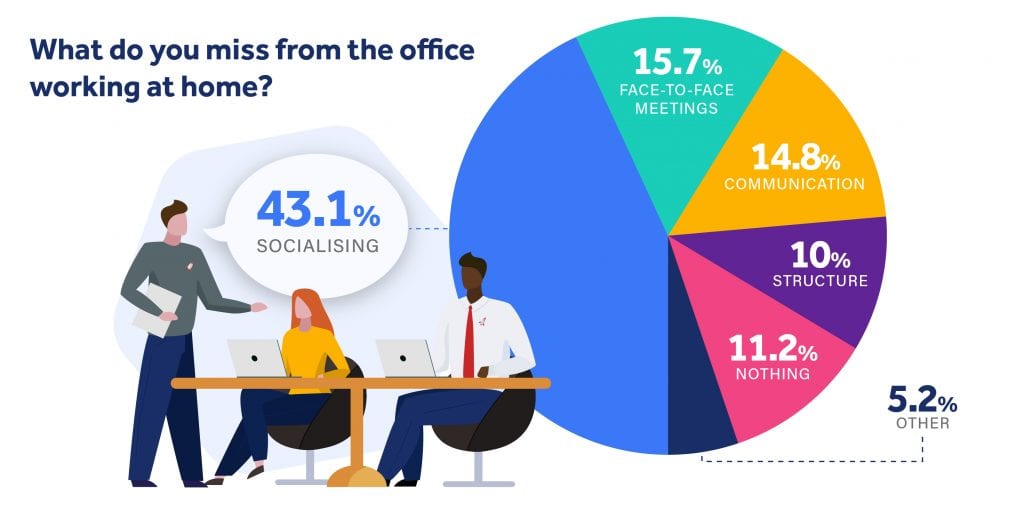
11.2% answered ‘nothing’ to this question, while some people answered with things like “free coffee”, “ping pong” and “the office energy”. Some people even missed the commute, with one respondent saying that the commute was a time for them to get ready and focused for work.
“While I do miss the social aspect the most definitely, I can say that an open office is far more distracting than private quarters. Communication ended up being a non-factor too. With the help of Zoom and Google Hangouts, decisions can be made quickly, almost in the same time, it would take to walk across the office to talk to someone.”
Domantas Gudeliauskas – Marketing Manager at Zyro
60% of people would work at home if they had the option
“I love working from home! In fact it’s near impossible to go back to the office after this. The benefits of working from home (no commute, can stay with your pets, much more comfortable workspace and no-one staring over your shoulder) simply blow the disadvantages out of the water. I would not return to an office as long as I have the option of working remote.”
Katie Holmes – Outwit Trade
60% of people surveyed said they would work at home if they had the choice. What’s more, 52.6% said they don’t want to return back to a normal office after COVID-19.
On the whole, working at home has a number of benefits. It cuts the commute, saving hours off someone’s day. It gives them a space to concentrate on their job, increases their flexibility around the work and can help improve the work/home life balance.
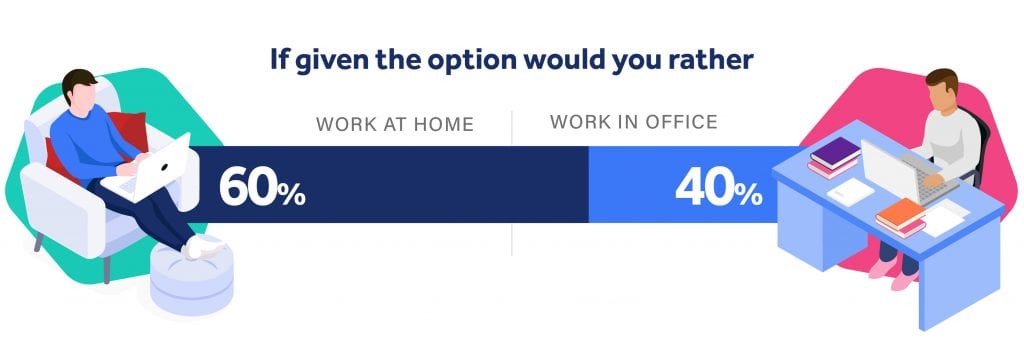
In the US, a similar study also repeated these findings, as 60.4% surveyed said they preferred working from home. In addition, 48.9% of them said they wished it was a permanent change.
It’s worth noting that this survey didn’t take into account the age of the participants. As ButcherBox CEO Mike Salguero suggests, the preference for working at home might depend on the age of the workers.
“For the younger demographic, I think they will likely want to be in a more traditional office for the socialization aspect. For older millennials with kids, they are likely to work from home more now to have a better balance and spend time with their families. The older population, say 50+, will probably come into the office even less. This is the time where that demographic is thinking about retirement, so they might either think about retirement earlier or think about a remote retirement where they retire to a new destination and still work remotely.”
Whether this preference is led by older demographics or not, one thing is clear: the majority of people want to stay working at home.
Less traditional, more flexible
“Not only does technology make remote work easy, but no commuting makes most employees more productive than ever, and companies can slash their second most expensive line item – their real estate budget – by championing remote work post-COVID-19”.
Jason Wolfson – SVP Marketing at VuPulse
It’s highly unlikely that all businesses will switch to a 100% remote working plan. The most likely outcome is that the traditional office will change, but become a more flexible and adaptive space to support remote workers.
One of the most popular responses is a call for working at home for the majority of the week, coming into the office for 2 days to meet others, socialise and brainstorm new ideas.
To Adam Lumb, EN Site Manager at Cashcow, the future of the traditional office depends on how much success businesses see during these months. If they see good results, they’re more likely to offer remote working in the future. In addition, if employees have a good experience working at home: “employees will also likely start to demand it.”
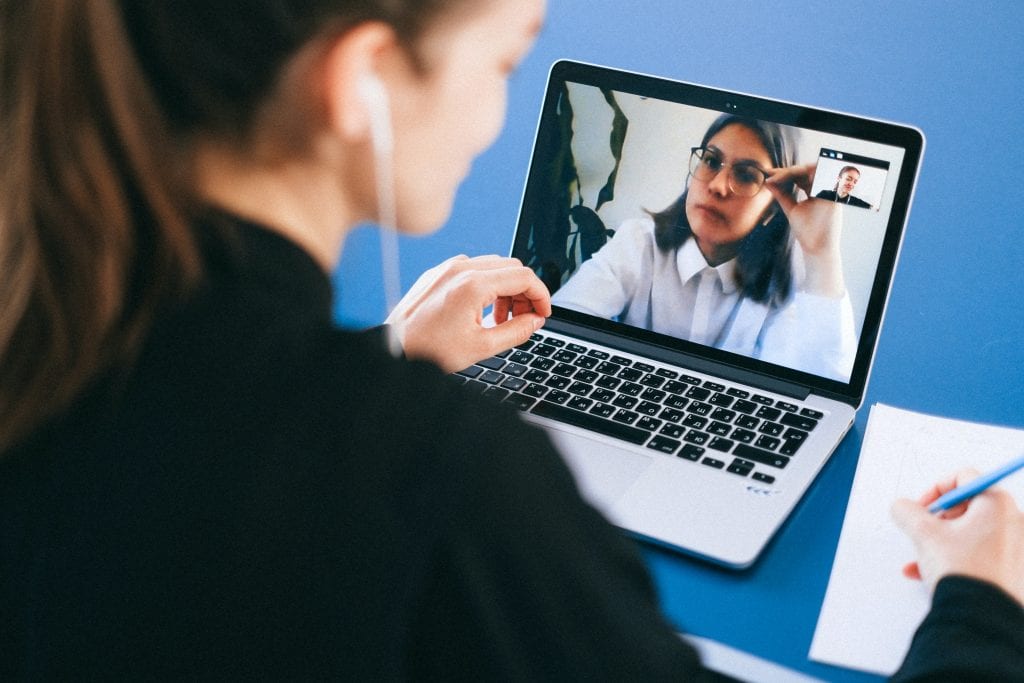
Remote working has its advantages to businesses. Levity Digital founder Stuart Cooke listed some of the best parts about having a remote company before the pandemic.
“The main advantage for us in being a remote company is that we get to hire the best staff from around the country, not just those who live nearby and the big advantage for our staff is that they get to prioritise their home lives above their work life which I think should always be the case.”
One of the biggest advantages to businesses is being able to save on real estate budgets. If you don’t need all of your employees in, you can downsize your space, switch to hot-desking and keep meeting spaces for collaborations. This is great for growing businesses, who don’t need to think about moving offices everytime they recruit new employees.
Ian Brock, Director of Digital Acquisition at Rateco, states that these savings can also be used to reinvest back into the people and the product, benefiting businesses even more.
Elliot Reimers of Rave Reviews stated that work shouldn’t just be remote, but also the adoption of flexible hours:
“The other benefit would be the ability for people to work when they are at the most productive. It would be great to see business adopt more flexi-working where there is a core time of work, for example 11am-3pm where meetings, discussions and internal admin can be completed with the team, but outside of that you can make your hours up at any time.”
At Adzooma, we have a similar flexible hours system in place. If you’re interested in that, you might want to check out the careers we’ve got going.
Are big brands planning a return to the office?
Although most plans are still up in the air at the minute, these are what some of the digital giants have announced for their employees.
- Google has told employees to expect to work at home until the end of the year, but are planning to open offices again in June for 10-15% of employees to come back.
- Facebook is planning to reopen offices on July 6th, but are allowing people to work at home until the end of the year. However, all in-person events have been cancelled until June 2021.
- Apple is already beginning to phase employees back to work after some employees are struggling to adapt to remote working and cannot access Apple’s internal systems from off-site.
- Microsoft was one of the first companies to send people home and hasn’t released any plans for office reopenings. The last news told employees to stay working at home until October.
The general response from most tech companies seems to be ‘wait and see’. Twitter on the other hand, took a different approach by boldly announcing employees will never have to go back to the office if they don’t want to.
Twitter has fully embraced remote working and it will be interesting to see if any other companies follow their lead in the months to come.
The effect of staying at home on your mental health with psychotherapist Paul Ansorge
Back in January, we surveyed hundreds of employees about their mental health. We found that 66% of people thought that working at home would have a positive effect on their mental health.
But with rising fears that ill mental health during the lockdown has increased, it can be difficult to say whether working at home will have a positive or negative effect on mental health.
To get a deeper understanding of this subject, we interviewed psychotherapist Paul Ansorge from The Reach Approach for his take.
66% of people said working at home helped them cope with their mental health. What are the positive effects of working at home on mental health and why?
There are a number of obvious benefits – not having the stress of a commute, being able to have more relaxing sleep as there is less time pressure, and not having the stress of being observed all day and feel like you have to put on a show, especially if you’re struggling.
On the other hand, there are significant mental health benefits to socialising, so a friendly and supportive workplace can be good for a person’s well-being. While many people have suggested they enjoy benefits from working from home, there have certainly been significant numbers of people struggling with the lack of human contact brought about by the current circumstances.
Another key positive can be that people can have an easier time of taking regular breaks – which as is widely understood is actually good for both productivity and well-being. That is something organisations would do well to take note of and genuinely encourage as working patterns return to previous “norms.”
“For some people like me, there are a lot of external factors that trigger stress out there, so working from home allows me to be focused and in flow.
It’s also made me more mindful of my personal health. I don’t have to get dressed properly and deal with traffic, so I’m able to focus on things like cooking my own meals and working out.”
Willie Greer – Founder of Product Analyst
What are the negative effects of working at home that people need to be careful of?
The aforementioned lack of social contact would be the key one here – as well as a kind of “four-walls” syndrome of a lack of variety of environment. If you do work from home, compensating for both these things with your non-work time is pretty crucial!

In your experience, would you say people are able to stereotypically cope with their mental health better working at home or in the office?
There really isn’t an easy answer to this question as it depends so much on the person and the nature of the workplace. There are certainly many people who benefit from being away from their work environments but that is far from universal. Mental health is also too multi-factorial for this to be easy.
Do you think a flexible remote working plan after COVID-19 can help improve mental health and why?
I think it can, but mental health should never be thought of a single-issue matter. It’s an immensely complex and vast subject and in the end depends on addressing the needs of the mind, body, spirit and environment. If on an individual basis a person can best address those needs by working at home – for example, having an environment that feels uplifting and reassuring rather than one which feels oppressive, or making healthier eating choices, or using the time they would have to use for commuting for meditation, exercise or mindfulness type activities then it could certainly be of benefit.
But so much of this depends on things that are not about working in an office versus working from home – the way in which employers treat their staff, what they expect from them and how they reward them are all massive factors in this arena.
What do employees and employers need to be conscious of when everyone returns back to office life?
I think it’s pretty clear that lots of people will be feeling a lot of anxiety about returning to “normal” too early, and there will be a huge range of different levels of commitment to things like social distancing among people with different levels of understanding about its importance. It’s going to be a pretty tricky time, so messaging should be really clear and honest. And of course, employers should pay more than just lip service to providing mentally healthy surroundings – that is, of course, always the case, though sadly productivity and profit are generally prized considerably ahead of well being.
“Employers must also be wary of the mental health issues – too much isolation is unquestionably bad for people and allowing any significant amount of time working from home brings that responsibility upon the employer.”
Ian Lockwood – Director of Boom Online Marketing
With health services stretched, what services/tools would you recommend to those struggling right now?
The truth is the health service in the UK has massively struggled with the mental health arena long before the current crisis. A decade of austerity has meant cuts to services across the board with often only the most meagre help available even after extraordinarily long waits.
If you need resources now, we have plenty of free self-help resources our website and YouTube channel, including tips on how to stay mentally healthy during COVID-19.
For more tips on keeping yourself mentally healthy during the lockdown, see our post on how to manage your mental health as a digital marketer during COVID-19.
Professor Irene Hardill and Dr Daniel Wheatley on the challenges of remote working
What are the challenges of remote working on businesses as a whole?
We interviewed Irene Hardill, Professor of Public Policy at Northumbria University and Dr Daniel Wheatley, Director of Undergraduate Programmes at Birmingham University for their insights.
Here’s what they had to say.
How has remote working changed in the pandemic?
Traditionally it has been the self-employed who have been 100% home-based and employees with higher degrees/professional qualification who have job autonomy (e.g. managers and professionals) who are able to blur the boundary between work and home (See: Hardill, 2012). But with the introduction of policies to combat Covid-19 far greater numbers of employees – including those with limited job autonomy – are now homeworking 100% of the time.
Traditional concerns of trust in completing work tasks, which has often been the site of conflict between workers and their employer overuse of company time resulting in high levels of monitoring worker activity, have been balanced with the need for expediency in getting the job done.
A practical challenge faced already is in the capacity of organization systems to cope with large-scale remote working. This has highlighted both the practical realities of Information and Communication Technologies (ICTs) being used so widely, but also evidence of historic lack of investment in remote working by some employers, many of whom have remained too strongly wedded to traditional work routines.
Some of the most noticeable examples of technology adoption are communication apps Zoom growing from 10 million users to over 200 million during the pandemic and Slack gaining 2.5 million users in a single week.
What challenges does remote working present?
Health and safety concerns still remain for those home working using ICTs, raising the question of whether employers have addressed these to the satisfaction of employees. Not all employees will have found remote working a stress-free experience, including juggling work with added childcare responsibilities; domestic disharmony; lack of appropriate home space for a work station; concerns regarding the security of company documents and meetings conducted entirely online.
A particular challenge faced by employees is the potential for overwork among those who have recently moved to remote working. Recent analysis performed on the CIPD’s 2019 UK Working Lives Survey highlighted the potential for significant overwork amongst those working at home. This shows the importance of taking ownership over how we work when outside of the traditional workplace and ensuring we balance work effectively, including taking breaks, so that we are able to work productively and preserve our wellbeing.
Additional challenges organizations will face in the coming months include managing the phased lifting of social distancing guidelines, and organising working in open-plan offices. A phased lifting of social distancing may mean that it is expedient to blend homeworking and office working, as social distancing would not allow all staff to be onsite at the same time. Another potential longer-term consideration for organizations who may have embraced the move to remote working relates to the cost savings in supporting remote working against reducing the size of office space. These considerations also have implications for HR, who will face challenges in managing employees once remote working is lifted.
These challenges must be contextualised, though, against the range of potential benefits that homeworking can deliver. Research conducted using data from the British Household Panel Survey evidenced the positive impact that working at home can have on job and leisure satisfaction, including the benefits of time gained from not commuting. Research in Work and Occupations using two separate years of data for 20,000 employees from the Understanding Society survey, further showed that the greater the levels of control someone has over their work tasks and schedule, the more significant the wellbeing benefits. These findings demonstrate some of the benefits which can be realised from workers having greater levels of control over their own working lives, enabling better management of work alongside household responsibilities.
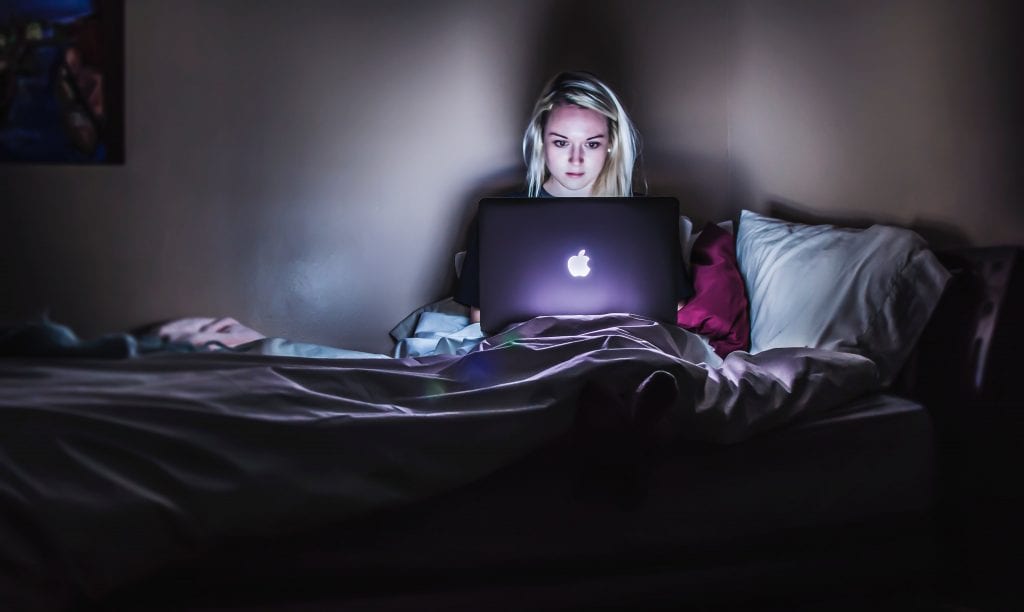
Can remote working offer long-term benefits?
Although challenging in the current climate, embracing flexible modes of work such as working at home – including relevant investment in technology to enable this – will not only deliver potential organizational benefits but also increase the adaptability of the labour market in the short and longer term.
Although perhaps not the central concern of many in the current climate, ‘good’ home-based work is achievable and perhaps even a solution to the current work-based dilemma created by COVID-19, and should be a common goal for individuals, organisations and society.
Overcoming challenges when working at home
“Keeping your mind in work mode when your home and work environments are the same and have no physical separation is hard; I feel like my mind is split somewhat during working hours but also during my personal time too.”
Polly Kay – Senior Marketing Manager at English Blinds
As shown above, one of the biggest challenges when working at home is to keep your work and home life separate.
One of the ways to help with this is to set up a physical space in your home that is exclusively for work. When it’s time for work, you go there and when your day is done you can leave the space behind and help mentally take a break from it.
However, this isn’t an option for all employees.
CJ Xia, VIP of Marketing & Sales at Boster Biological Technology mentioned the cost to employees for setting up an office at home. This doesn’t just include the cost of equipment, but also the loss of living space in your home by separating your workplace. For some people, such as those living in small apartments or with children, this separation might not be possible.
If workplaces move to more remote working after lockdown, perhaps this will lead to increased use of hotdesk and shared workspaces.
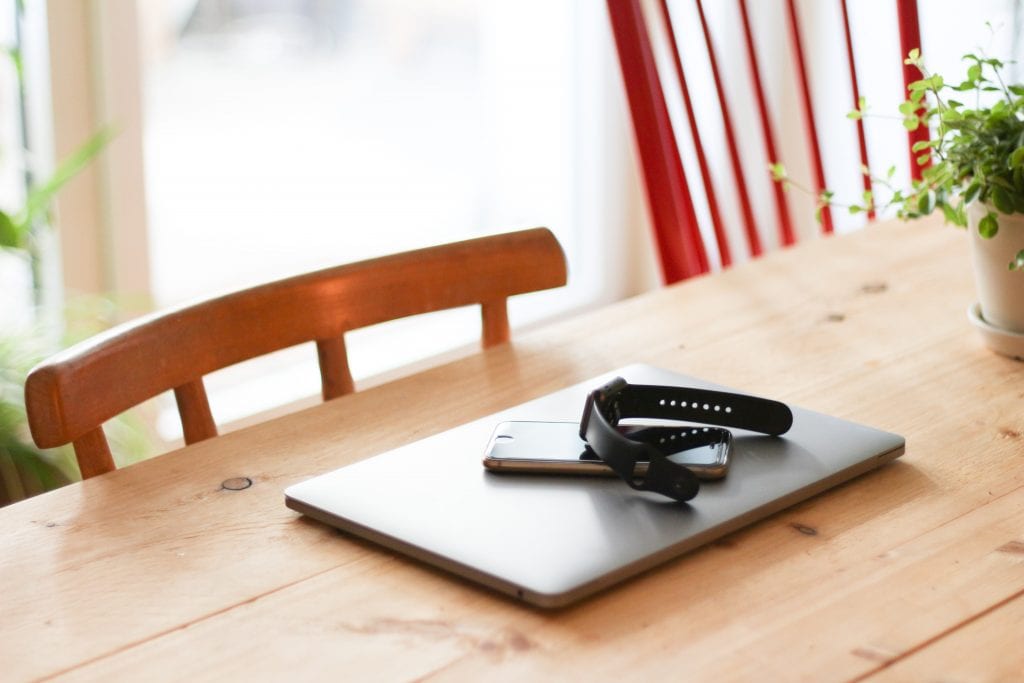
“On the one hand, I have more time for self-education when I don’t have to spend several hours commuting. On the other hand, it is easier to resolve problems with colleagues when you are all at the office. Work-live boundaries are also an issue: you need to maintain a schedule, take regular breaks and shut down your computer at the end of the day to avoid burnout.”
Llia Sotniko – Vice President of Product Management at Netwrix
The traditional office will forever be changed
No matter what strategy most businesses choose to adopt after COVID-19, the office as we know it will be changed.
Employees and businesses around the world now have first-hand experience at how productive remote working can be. With 52.6% saying they never want to go back to an office, it’s likely that employees will demand remote working options in their career.
The businesses that offer remote working are going to be in the lead to recruit the best employees.
It’s unlikely that businesses will opt for a 100% remote strategy, with a lot of employees missing office environments, socialising with others and not being able to conduct face-to-face meetings. However, this will be most likely on a flexible basis, with office environments being transformed into meeting and hotdesk zones.
And with new social distancing measures incorporated into office design, COVID-19 has brought an end to the traditional office.
* Methodology
Data collected from 448 anonymous responses from employees currently working at home. 58% of the respondents worked within a digital marketing industry, but the survey also collected responses from industries such as Health/Fitness, Security, Retail and Sport. The Survey was distributed to a range of companies including Google, Facebook, MediaCom, The British Forces Broadcasting Services, Boom Digital, Impression and Hallam Internet.
